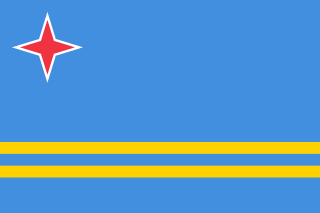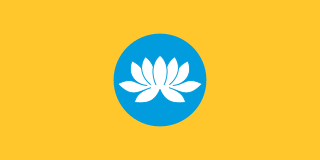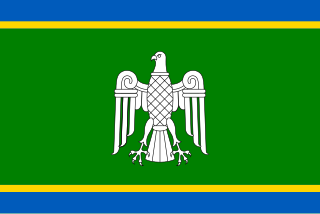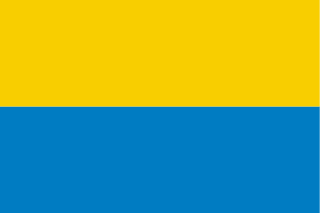
The national flag of Aruba was adopted on 18 March 1976, along with the official anthem "Aruba Dushi Tera". The flag was partially designed by vexillologist Whitney Smith. On 18 March Aruba celebrates National Anthem and Flag Day, marked by local events across the island. It is also a significant day as it represents the Kingdom of the Netherlands giving Aruba an autonomous status.

The national flag of the Kingdom of Belgium is a tricolour consisting of three equal vertical bands displaying the national colours: black, yellow, and red. The colours were taken from the coat of arms of the Duchy of Brabant, and the vertical design may be based on the flag of France. When flown, the black band is nearest the pole. It has the unusual proportions of 13∶15.

The national flag of Mauritania is a green field containing a gold star and crescent, with two red stripes at the top and bottom of the field. The original national flag was introduced under the instructions of President Moktar Ould Daddah and the constitution of 22 March 1959 and was officially adopted on 1 April 1959.

The national flag of Cape Verde was adopted on 22 September 1992, replacing the flag adopted during independence.

The national flag of Ecuador, which consists of horizontal bands of yellow, blue and red, was first adopted by law in 1835 and later on 26 September 1860. The design of the current flag was finalized in 1900 with the addition of the coat of arms in the center of the flag. Before using the yellow, blue and red tricolor, Ecuador's former flag had three light blue stripes and two white stripes with three white stars for each province of the country. The design of the flag is very similar to those of Colombia and Venezuela, which are also former constituent territories of Gran Colombia. All three are based on a proposal by Venezuelan General Francisco de Miranda, which was adopted by Venezuela in 1811 and later Gran Colombia with some modifications. There is a variant of the flag that does not contain the coat of arms that is used by the merchant marine. This flag matches Colombia's in every aspect, but Colombia uses a different design when her merchant marine ships are at sail.

The flag of Spain, as it is defined in the Constitution of 1978, consists of three horizontal stripes: red, yellow and red, the yellow stripe being twice the height of each red stripe. Traditionally, the middle stripe was defined by the more archaic term of gualda, and hence the popular name la Rojigualda (red-weld).

The flag of the U.S. state of Colorado was officially adopted on June 5, 1911. The flag, designed by Andrew Carlisle Carson, consists of a fess design of three horizontal stripes of equal width, with the top and bottom stripes colored blue, and the middle stripe colored white. A circular red "C", filled with a golden disk, sits atop the stripes. All aspects of the flag contain symbolism related to the state, as the blue is meant to represent the sky, the gold the abundant sunshine the state receives, the white the snowcapped Rocky Mountains, and the red the "ruddy" earth. The gold and white portions of the flag also represent the state's gold and silver mining industries, respectively.

The flag of Udmurtia is one of the official state symbols of the Udmurt Republic, along with its emblem and anthem. The proportion of width and length of the flag is 1:2. It is a rectangular three-color cloth consisting of vertical equal stripes of black, white and red with an eight-pointed red cross. The black colour in the flag is a symbol of the earth and stability, red means the sun and life and white means a space and moral purity. The designer of the flag of the Udmurt Republic was Yuri Lobanov. The appropriate law N26-РЗ "On the National Flag of the Udmurt Republic" appeared on 30 April 2002.

The flag of Kalmykia consists of a yellow field with a sky blue circle in the center containing a lotus. The yellow stands for the sun, the people and the religious faith of the nation. The blue represents the sky, eternity, and steadiness. The lotus is a symbol of purity, spiritual rebirth and happiness. Its five upper petals represent the continents and the lower four stand for the quarters of the globe. Together, they symbolize the will of the Kalmyks to live in friendship and to cooperate with all the nations of the world.

The flag of the Chernivtsi Oblast is the official flag of Chernivtsi Oblast, an oblast in Ukraine. It was officially adopted on December 12, 2001.

The civil flag that serves as the symbol of the state of Mecklenburg-Vorpommern, Germany, consists of five horizontal stripes, that are from the top to bottom: blue (ultramarine), white, yellow, white, and red (vermilion). It was designed by Norbert Buske and adopted on 29 January 1991. It is a combination of the historical flags of the Mecklenburg and Western Pomerania.

The Flag of Novosibirsk Oblast is the official symbol of Novosibirsk Oblast, Russia.

The flag that serves as the symbol of the historical and geographical regions of the Silesia, and Lower Silesia, and as one of the symbols of the Silesian people, is divided horizontally into two stripes: white on the top and yellow on the bottom. It originated as the flag of the Province of Silesia, used from 1882 to 1919, that later used as the flag of the Province of Lower Silesia, from 1920 to 1935. Currently, the flag is recognized symbol of the Silesian people in the state of Saxony in Germany.

The flag that serves as the symbol of the historical and geographical region of the Upper Silesia in Poland, and as one of the symbols of the Silesian people, is divided horizontally into two stripes: yellow on the top and blue on the bottom. It originated as the flag of the Province of Upper Silesia adopted in 1920, with its colours based on the coat of arms of Upper Silesia. The flag is also popular symbol used by the Silesian Autonomy Movement and the Silesian Separatist Movement

The civil flag of the Silesian Voivodeship, Poland is triband rectangle, divided into three horizontal stripes, that are from top to bottom: blue, yellow, and blue. The blue stripes are twice the size of the yellow middle stripe. The state flag is a blue rectangle with yellow eagle placed in its centre. It was designed by Barbara Widłak, and adopted on 11 June 2001.

The flag of the Świętokrzyskie Voivodeship, Poland is a rectangle divided into four parts. Its left part features a yellow vertical stripe, which wight equals to 1:4 of the wight of the flag. Its right part is divided into three horizontal stripes, that are, from top to bottom: blue, white, and red. In the middle of the white stripe is placed the coat of arms of the voivodeship. The first version of the flag had been adopted in 2001, and current version is used since 2013.

The flag that serves as the symbol of the historical and geographical region of the Western Pomerania is divided horizontally into two stripes: light blue on the top and white on the bottom. It originated as the flag of the Province of Pomerania, Prussia, used from 1882 to 1935. Since 1996, it is officially recognized as the symbol of the historical region of Western Pomerania within Mecklenburg–Western Pomerania, Germany.

The flag, that serves as the symbol of the city of Zielona Góra, Lubusz Voivodeship, in western Poland, is divided into three fields, including the vertical yellow stripe on the left, and two equally-sized horizontal stripes, white on the top, and green on the bottom, on the right. It was established in 1965.

The flag that serves as the symbol of the historical and geographical region of the Mecklenburg is divided horizontally into two stripes: light blue on the top and white on the bottom. It originated as the flag of the Grand Duchy of Mecklenburg-Schwerin, adopted in 1813. Since 1996, it is officially recognized as the symbol of the historical region of Mecklenburg within Mecklenburg-Vorpommern, Germany.



















